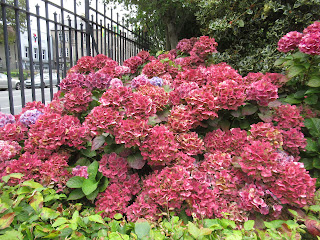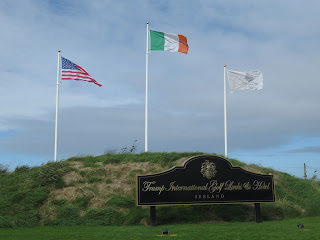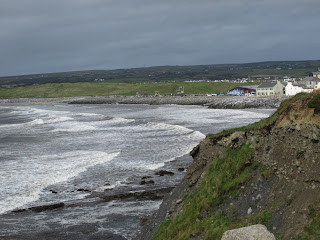After three nights and two full days in and around delightful Dingle, we headed north toward Galway in western Ireland. Having seen so much of the coastal Dingle Peninsula, we drove across the peninsula through Conor Pass or An Chonair as it's known in Gaelic.
The ride over An Chonair was the highest mountain crossing on the Wild Atlantic Way, the tourist drive that borders most of the island. On a clearer day, we could have seen Loop Head in County Clare, the Aran Islands and the beaches in Castlegregory but our views were still nothing to complain about!
Ice shaped this landscape as, about 20,000 years ago, thick ice sheets covered much of Ireland. A glacier flowed slowly from here, picking up debris as it moved. When the ice melted about 14,000 years ago, it left behind this Alpine landscape with jagged peaks, deep lakes and U-shaped valleys.
While Killarney (which we'd visited about five days previously from Kenmare) was definitely the tour-bus capital of County Kerry, Tralee was its market and transit hub. We figured the town was worth an hour or so stop to see the Kerry County Museum located in the Ashe Memorial Hall in the center of town.
One of the exhibits was called Gowns of Glory which showed the Rose of Tralee dresses through the decades. The Rose of Tralee Festival is held every August and takes its inspiration from the 19th century ballad of the same name. The centerpiece is a competition, broadcast live on national TV, in which a young woman is crowned as the Rose of Tralee. I was surprised to read that entrants come from over 60 Rose Centres globally and the winning Rose represents the Festival and Ireland in a year-long ambassadorial role at home and abroad. Quite a few of the Roses came from Australia or even the US, I saw.
I noticed how the dresses reflected the fashion trends of the time; remember our wearing, in the 1980s, dresses with puffy sleeves and flouncy skirts?!
I wasn't surprised to read that the Rose of Tralee, though a national institution, is loved and loathed in equal measure. Its critics argue that it's a relic of an Ireland that no longer exists,with outdated notions of Irish femininity. Supporters point to the increasing diversity of the Roses as reflecting a changing Ireland.
One of the few early medieval brooches found in Kerry was inadvertently discovered when a woman, clearing out the ashes from her grate after a sod of turf had burned, saw it! The brooch had been concealed in the family's bog but miraculously survived. Used to fasten clothing, it had the first two letters of Christ's name in the Greek alphabet on it, an extremely rare early Christian symbol found in Ireland.
In 1894, crowds watched the NY-bound emigrant liner SS Corean in trouble off nearby Scattery Island after her cargo shifted in mountainous seas and she started to take in water. Fortunately, the 100 passengers eventually continued their journey.
A sign proudly indicated that Mohammed Ali's great-grandfather is thought to have emigrated from Cappagh Pier to NY in the 1860s. He later changed his name to Abe O'Grady after President Abraham Lincoln!
Rather than heading northwest to the Cliffs of Moher, Ireland's most visited natural attraction, we instead drove south toward the Kilkee Cliffs on the Loop Head Peninsula as our research indicated we'd be in for a special treat! That was some of the best advice we could have gotten as the sight of the rock formations and the sheer cliffs was spectacular.
The entrance to the well:
The day continued for several hours still as we finally made it to the famous Cliffs of Moher and, one of my favorite sights in Ireland, The Burren. I'd hoped to include our stops to those places in this post but I am running out of steam knowing I have to be up in a few hours at 5:45 for a 12-hour plus day tour to Stonehenge, Bath, Windsor and Salisbury from here in London!
Next post: Bet you've already figured it out - the Cliffs of Moher and The Burren!
Posted on October 6th, 2019, from London.
Yup, another 'two lane road' although passing would have been tough.
The way we'd just come:
The sign at the bottom of the pass indicated in Gaelic, French and German respectively larger vehicles couldn't travel the narrow road!
The dramatic views of the waterfalls off the cliffs which filled in Peddlars' Lake below.
When we passed this pub by, I couldn't get to my camera fast enough to take a photo so I had Steven stop and turn around in the rain as I thought it was too cute to miss!
On the western edge of Tralee at the base of the Dingle Peninsula was the Blennerville Windmill originally built in 1780. It ground grain to feed Britain as England entered into the Industrial Age. The small town of Blennerville was a major port for American-bound emigrants in the 19th century.
The information stressed the competition is neither a beauty pageant nor a talent contest but combined elements of both in the search for"a young woman who possesses the elusive quality expressed in the song as 'the truth in her eyes ever dawning.' " The exhibit illustrated the changing styles in the dresses worn by the winning Roses over the past decades. In the early years, the Roses either made their own or bought them off the rack. That changed when the competition was broadcast live and designers became keen to get their styles shown on one of the nation's most watched TV programs.
I noticed how the dresses reflected the fashion trends of the time; remember our wearing, in the 1980s, dresses with puffy sleeves and flouncy skirts?!
After seeing so many Irish High Crosses in a number of cemeteries, I was intrigued to learn that their building represented the height of stone carving tradition. The magnificent 9th and 10th century monuments, decorated with finely carved Biblical scenes, were probably used to instruct an illiterate population. The crosses are regarded as one of Ireland's unique contributions to European Christian culture.
The Bronze Crucifixion Figure was found on Skellig Michael and was dated 1150.
I thought the rest of the museum was a bust as several of the exhibits we'd hoped to see were closed for renovations or we were't terribly interested in what there was to see. We then wandered down Tralee's main street where we saw lots of flags flying for Kerry's football team.
The monument was erected by the Nationalists of County Kerry to commemorate the heroes who sacrificed their lives and liberties in independence conflicts for Ireland.
Rather than driving all the way around the Limerick Peninsula, we took the short ferry ride across River Shannon from Tarbet to Killimer in County Clare. Steven and I joked how we must have had 'the luck of the Irish' with us that day as we drove right on the ferry and they closed up the plank right behind us!
We stopped for a few minutes at the Cappagh Pier where we read that people in the 19th century traveled to this part of County Clare by taking a boat down the River Shannon from Limerick. Seven ships in the Spanish Armada landed close by here seeking refuge and supplies.
Rather than heading northwest to the Cliffs of Moher, Ireland's most visited natural attraction, we instead drove south toward the Kilkee Cliffs on the Loop Head Peninsula as our research indicated we'd be in for a special treat! That was some of the best advice we could have gotten as the sight of the rock formations and the sheer cliffs was spectacular.
What made the Kilkee Cliffs one of our favorite spots all trip was its almost total isolation. We felt we'd discovered a piece of heaven on earth and it was our own secret place! What a shame we didn't have hours to spend just soaking up the sun in this special place as it was so darn beautiful.
The squiggles meant we were still on the Wild Atlantic Way!
Obviously a well trodden path but not that day when we had it to ourselves save for a couple of others.
When we dragged ourselves away from the cliff top, we found an almost equally lovely spot, the town of Kilkee itself with its picture perfect beach and promenade. Before coming to Ireland, I'd never thought it would be a destination place for beach lovers - wow, was I wrong, I discovered after seeing so many lovely ones.
As we finally headed north to the Cliffs of Moher, we just happened to pass Trump's golf course. If you follow politics, you probably read about the flap because Vice President Pence chose to stay here at Trump's golf course located in the hamlet of Doonbeg on the far west coast of Ireland when he was had business way over in Dublin on the east coast of Ireland a few weeks ago. Pence couldn't have gotten accommodations further away if he tried!
Another breathtakingly glorious viewpoint was at Lehinch in Liscannor Bay on the northwest coast of County Clare. For some reason, as soon as we crossed over into County Clare, we didn't spot one more football flag anywhere. The absence was striking as it seemed you couldn't travel anywhere in southern Ireland and not see a family's, a business's or a town's loyalty plastered everywhere.
St. Brigid's Well in Liscannor was one of the most visited holy wells in Ireland. Faithful adherents were supposed to recite a certain prayer, then walk around the statue five times praying while making sure to keep the statue on their right, then walk up and around the steps five times while praying; then circle the cross five times and then kiss the cross; and finally pray at the well. You can count me as a sinner as I failed to do all but say a few prayers.
The entrance to the well:
The day continued for several hours still as we finally made it to the famous Cliffs of Moher and, one of my favorite sights in Ireland, The Burren. I'd hoped to include our stops to those places in this post but I am running out of steam knowing I have to be up in a few hours at 5:45 for a 12-hour plus day tour to Stonehenge, Bath, Windsor and Salisbury from here in London!
Next post: Bet you've already figured it out - the Cliffs of Moher and The Burren!
Posted on October 6th, 2019, from London.





























































WoW !! The Cliffs of Kilkee are truly a piece of heaven .. the luck of the Irish certainly followed you today ! xo
ReplyDelete